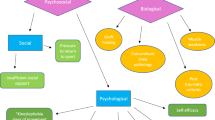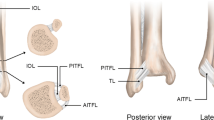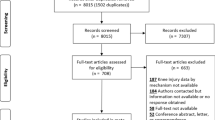Abstract
Ankle injuries, especially ankle sprains, are a common problem in sports and medical care. Ankle sprains result in pain and absenteeism from work and/or sports participation, and can lead to physical restrictions such as ankle instability. Nowadays, treatment of ankle injury basically consists of taping the ankle. The purpose of this review is to evaluate the effectiveness of ankle braces as a treatment for acute ankle sprains compared with other types of functional treatments such as ankle tape and elastic bandages.
A computerized literature search was conducted using PubMed, EMBASE, CINAHL and the Cochrane Clinical Trial Register. This review includes randomized controlled trials in English, German and Dutch, published between 1990 and April 2009 that compared ankle braces as a treatment for lateral ankle sprains with other functional treatments. The inclusion criteria for this systematic review were (i) individuals (sports participants as well as non-sports participants) with an acute injury of the ankle (acute ankle sprains); (ii) use of an ankle brace as primary treatment for acute ankle sprains; (iii) control interventions including any other type of functional treatment (e.g. Tubigrip®, elastic wrap or ankle tape); and (iv) one of the following reported outcome measures: re-injuries, symptoms (pain, swelling, instability), functional outcomes and/or time to resumption of sports, daily activities and/or work. Eight studies met all inclusion criteria. Differences in outcome measures, intervention types and patient characteristics precluded pooling of the results, so best evidence syntheses were conducted. A few individual studies reported positive outcomes after treatment with an ankle brace compared with other functional methods, but our best evidence syntheses only demonstrated a better treatment result in terms of functional outcome. Other studies have suggested that ankle brace treatment is a more cost-effective method, so the use of braces after acute ankle sprains should be considered. Further research should focus on economic evaluation and on different types of ankle brace, to examine the strengths and weaknesses of ankle braces for the treatment of acute ankle sprains.





Similar content being viewed by others
References
Fong DT, Hong Y, Chan LK, et al. A systematic review on ankle injury and ankle sprain in sports. Sports Med 2007; 37 (1): 73–94
Schmikli SL, Kemler HJ, Backx FJG. Blessureleed in de sport 2000–2004. In: Hildebrandt VH, Ooijendijk WTM, Hopman-Rock M, editors. Trendrapport Bewegen en Gezondheid 2000/2005. Leiden: TNOKwaliteit van Leven, 2007
Brooks SC, Potter BT, Rainley JB. Treatment for partial tears of the lateral ligament of the ankle: a prospective trial. Br Med J 1981; 282: 606–7
McCulloch PG, Holden P, Robson DJ, et al. The value of mobilisation and non-steroidal anti-inflammatory analgesiain the management of inversion injuries of the ankle. Br J Clin Pract 1985 Feb; 39 (2): 69–72
Ruth CJ. The surgical treatment of injuries of the fibular collateral ligaments of the ankle. J Bone Joint Surg 1961 Mar; 43-A: 229–39
Mann G, Nyska M, Constantini N, et al. Mechanics of injury, clinical presentation and staging. In: Nyska M, Mann G, editors. The unstable ankle. Champaign (IL): Human Kinetics, 2002: 54–61
Renström P, Lynch SA. Management of acute ankle sprains. In: Nyska M, Mann G, editors. The unstable ankle. Champaign(IL): Human Kinetics, 2002: 168–78
Verhagen E, van Tulder M, van der Beek AJ, et al. An economic evaluation of a proprioceptive balance boardtraining program for the prevention of ankle sprains involleyball. Br J Sports Med 2005; 39 (2): 111–5
Harrington KD. Degenerative arthritis of the ankle secondary to long-standing lateral ligament instability. J Bone Joint Surg Am 1979; 61 (3): 354–61
Krips R, Brandsson S, Swensson C, et al. Anatomical reconstruction and Evans tenodesis of the lateral ligamentsof the ankle: clinical and radiological findings after follow-upfor 15 to 30 years. J Bone Joint Surg Br 2002; 84 (2): 232–6
Hubbard TJ, Hicks-Little CA. Ankle ligament healing after an acute ankle sprain: an evidence-based approach. J Athl Train 2008 Sep-Oct; 43 (5): 523–9
Ekstrand J, Gilquist J. Soccer injuries and their mechanisms: a prospective study. Med Sci Sports Exerc 1983; 15 (3): 267–70
Tropp H, Askling C, Gilquist J. Prevention of ankle sprains. Am J Sports Med 1985; 13 (4): 259–61
van Rijn RM, van Os AG, Bernsen RM, et al. What is the clinical course of acute ankle sprains? A systematic literaturereview. Am J Med 2008 Apr; 121 (4): 324–31
Prins JG. Diagnosis and treatment of injury to the lateral ligaments of the ankle. Acta Chir Scand Suppl 1978; 486: 65–137
Hedges JR. Mangement of ankle sprains. Ann Emerg Med 1980; 9 (6): 296–302
Schaap GR, de Keizer G, Marti RK. Inversion trauma of the ankle. Arch Orthop Trauma Surg 1989; 108: 273–5
Cetti R. Conservative treatment of injury to the fibular ligament of the ankle. Br J Sports Med 1982; 16: 47–52
Korkala O, Rusanen M, Kytömaa J, et al. Treatment of lateral ligament injuries of the ankle: a prospective clinicalstudy [abstract]. Acta Orthop Scand 1986; 57 (6): 579
Zwipp Z, Hoffmann R, Thermann H, et al. Rupture of the ankle ligaments. Int Orthop 1991; 15 (1): 245–9
van Beek P. Evaluation of ankle injuries using the Cybex II Dynamometer [abstract]. Acta Orthop Scand 1985; 56 (6): 516
Brink PRG, de Vette J, Wever J, et al. Treatment of 176 ankle ligament ruptures by taping; results after 2–3 years[abstract]. Acta Orthop Scand 1985; 56 (6): 515
Kannus P, Renström P. Treatment for acute tears of the lateral ligaments of the ankle: operation, cast, or early controlledmobilization. J Bone Joint Surg Am 1991; 73: 305–12
Kerkhoffs GMMJ, Rowe BH, Assendelft WJJ, et al. Immobilisation for acute ankle sprain: a systematic review. Arch Orthop Trauma Surg 2001; 121: 462–71
Jones MH, Amendola AS. Acute treatment of inversion ankle sprains: immobilization versus functional treatment. Clin Orthop Relat Res 2007 Feb; 455: 169–72
Kerkhoffs GM, Struijs PA, Marti RK, et al. Different functional treatment strategies for acute lateral ankle ligament injuries inadults. Cochrane Database Syst Rev 2002; (3): CD002938
The Chartered Society of Physiotherapy. PRICE guidelines: guidelines for the management of soft tissue (musculoskeletal) injury with Protection, Rest Ice, Compression and Elevation (PRICE) during the first 72 hours (ACPSM) [online]. Available from URL: http://www.csp.org.uk [Accessed2010 Dec 7]
NHG (Dutch General Practitioner College). Guideline on ankle sprain [online; in Dutch]. Available from URL: http://nhg.artsennet.nl [Accessed 2010 Dec 7]
Handoll HHG, Rowe BH, Quinn KM, et al. Interventions for preventing ankle ligament injuries. Cochrane DatabaseSyst Rev 2001; (3): CD000018
Verhagen EA, van Mechelen W, de Vente W. The effect of preventive measures on the incidence of ankle sprains. ClinJ Sport Med 2000 Oct; 10 (4): 291–6
Definition of ankle brace [online]. Available from URL: http://www.thefreedictionary.com [Accessed 2010 Dec 7]
Sherrington C, Herbert RD, Maher CG, et al. PEDro: a database of randomized trials and systematic reviews inphysiotherapy. Man Ther 2000 Nov; 5 (4): 223–6
Maher CG, Sherrington C, Herbert RD, et al. Reliability of the PEDro Scale for rating quality of randomized controlled trials. Phys Ther 2003 Aug; 83 (8): 713–21
van Peppen RP, Kwakkel G, Wood-Dauphinee S, et al. The impact of physical therapy on functional outcomes after stroke:what’s the evidence? Clin Rehabil 2004 Dec; 18 (8): 833–62
Altman DG. Practical statistics formedical research. London: Chapman & Hall, 1999
Steultjens EM, Dekker J, Bouter LM, et al. Occupational therapy for stroke patients: a systematic review. Stroke 2003 Mar; 34 (3): 676–87
van Tulder MW, Cherkin DC, Berman B, et al. The effectiveness of acupuncture in the management of acute andchronic low back pain: a systematic review within the frameworkof the Cochrane Collaboration Back Review Group. Spine 1999; 24: 1113–23
Dettori JR, Basmania CJ. Early ankle mobilization, part II: a one-year follow-up of acute, lateral ankle sprains (a randomizedclinical trial). Mil Med 1994; 159 (1): 20–4
Eiff MP, Smith AT, Smith GE. Early mobilization versus immobilization in the treatment of lateral ankle sprains. Am J Sports Med 1994; 22 (1): 83–8
Klein J, Rixen D, Albring T, et al. Functional treatment with a pneumatic ankle brace versus cast immobilization forrecent rupture of the fibular ligament in the ankle: a randomizedclinical trial. Unfallchirurg 1991; 94 (2): 99–104
Nyska M, Weisel Y, Halperin N, et al. Controlled mobilization after acute ankle inversion injury. J Sports Traumatol Rel Res 1999; 21 (2): 114–20
Regis D, Montanari M, Magnan B, et al. Dynamic orthopaedic brace in the treatment of ankle sprains. Foot Ankle Int 1995; 16 (7): 422–6
Avci S, Sayli U. Comparison of the results of short-term rigid and semi-rigid cast immobilization for the treatment of grade3 inversion injuries of the ankle. Injury 1998; 29 (8): 581–4
Johannes EJ, Kaulesar SDMKS, Spruit JLM, et al. Controlled trial of a semi-rigid bandage (“scotch wrap”) in patients withankle ligament lesions. Curr Med Res Opin 1993; 13 (3): 154–62
Jongen SJM, Pot JH, Dunki Jacobs PB. Treatment of the sprained ankle [in Dutch]. Geneeskd Sport 1992; 25 (3): 98–101
Tufft K, Leaman A. A better form of treatment? Comparison of wool and crepe, and elasticated tubular bandages in thetreatment of ankle sprains. Prof Nurse 1994; 9 (11): 745–6
Watts BL, Armstrong B. A randomised controlled trial to determine the effectiveness of double Tubigrip in grade 1 and 2 (mildto moderate) ankle sprains. Emerg Med J 2001; 18 (1): 46–50
Altizer L. Strains and sprains. Orthop Nurs 2003; 22 (6): 404–9
Connolly JF. Acute ankle sprains: getting and keeping patients back up on their feet. Consultant 1996 Aug; 36 (8): 1631–43
Kerkhoffs GMMJ, Pijnenburg ACM, De Vries JS, et al. Management of acute ankle sprain in athletes. Schweizer ZMed Traumatol 2003; 51 (2): 112–4
Loveridge N. Lateral ankle sprains. Emerg Nurse 2002; 10 (2): 29–33
MacAuley D. Ankle injuries: same joint, different sports. Med Sci Sports Exerc 1999 Jul; 31 (7 Suppl.): S409–11
Meisterling RC, Johnson RJ. Recurrent lateral ankle sprains. Phys Sportsmed 1993; 21 (30): 123–9
Soosai NS, Nwachukwu I, Forester A. A prospective randomised trial comparing the Aircast® ankle brace withconservative treatment for lateral ligament injuries of the ankle [abstract]. J Bone Joint Surg Br 1997; 79 Suppl.2: 250
Wilkerson GB, Horn-Kingery HM. Treatment of the inversion ankle sprain: comparison of different modes of compressionand cryotherapy. JOrthop Sports Phys Ther 1993; 17 (5): 240–6
Lamb SE, Nakash RA, Withers EJ, et al. Clinical and cost effectiveness of mechanical support for severe ankle sprains:design of a randomised controlled trial in the emergency department. BMC Musculoskelet Disord 2005; 6: 1 [online]. Available from URL: http://www.biomedcentral.com [Accessed 2008 Sep 9]
Leanderson J, Bergqvist M, Rolf C, et al. Early influence of an ankle sprain on objective measures of ankle joint function:a prospective randomised study of ankle brace treatment. Knee Surg Sports Traumatol Arthrosc 1999; 7 (1): 51–8
Beynnon BD, Renström PA, Haugh L, et al. A prospective, randomized clinical investigation of the treatment of firsttimeankle sprains. Am J Sports Med 2006; 34 (9): 1401–12
Neumann K, Wittkämper V-I, Muhr G. Functional treatment for acute grade III tears of the lateral ligaments of theankle with and without a brace: a prospective randomizedstudy. Langenbecks Archiv fur Chirurgie 1994; 379 ( Suppl.Kongressbericht): 827–9
Boyce SH, Quigley MA, Campbell S. Management of ankle sprains: a randomised controlled trial of the treatment ofinversion injuries using an elastic support bandage or anAircast ankle brace. Br J Sports Med 2005 Feb; 39 (2): 91–6
Karlsson J, Eriksson BI, Swärd L. Early functional treatment for acute ligament injuries of the ankle joint. Scand JMed Sci Sports 1996; 6: 341–5
Leanderson J, Wredmark T. Treatment of acute ankle sprain comparison of a semi-rigid ankle brace and compression bandagein 73 patients. Acta Orthop Scand 1995; 66 (6): 529–31
Dettori JR, Pearson BD, Basmania CJ, et al. Early ankle mobilization. Part I: the immediate effect on acute, lateraankle sprains (a randomized clinical trial). Mil Med 1994 Jan; 159 (1): 15–20
Twellaar M, Veldhuizen JW, Verstappen FT. Ankle sprains: comparison of long-term results of functional treatmentmethods with adhesive tape and bandage (“brace”) andstability measurement. Unfallchirurg 1993; 96 (9): 477–82
Lamb SE, Marsh JL, Hutton JL, et al. Collaborative Ankle Support Trial (CASTGroup). Mechanical supports for acute,severe ankle sprain: a pragmatic, multicentre, randomisedcontrolled trial. Lancet 2009 Feb 14; 373 (9663): 575–81
Haraguchi N, Tokumo A, Okamura R, et al. Influence of activity level on the outcome of treatment of lateral ankleligament rupture. J Orthop Sci 2009; 14: 391–6
Vaes P, Duquet W, Handelberg F, et al. Objective roentgenologic measurements of the influence of ankle braceson pathologic joint mobility: a comparison of 9 braces. Acta Orthop Belg 1998; 64 (2): 201–9
Cooke MW, Marsh JL, Clark M, et al. CAST trial group. Treatment of severe ankle sprain: a pragmatic randomisedcontrolled trial comparing the clinical effectiveness andcost-effectiveness of three types of mechanical ankle supportwith tubular bandage. The CAST trial. Health Technol Assess 2009 Feb; 13 (13): iii,ix-x, 1–121
Acknowledgements
No sources of funding were used to assist in the preparation of this review. The authors have no conflicts of interest that are directly relevant to the content of this review.
Author information
Authors and Affiliations
Corresponding author
Rights and permissions
About this article
Cite this article
Kemler, E., van de Port, I., Backx, F. et al. A Systematic Review on the Treatment of Acute Ankle Sprain. Sports Med 41, 185–197 (2011). https://doi.org/10.2165/11584370-000000000-00000
Published:
Issue Date:
DOI: https://doi.org/10.2165/11584370-000000000-00000




